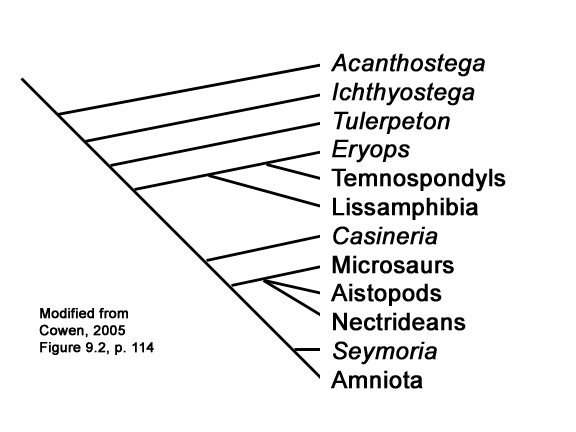
1. Most people think of vertebrates in terms of a conceptual progression:
lobe-fin fish -> amphibian -> reptile -> mammal or reptile ->bird
Cladistic classifications recognize only monophyletic taxa (i.e., "Rule of Monophyly"):
The lobe-fin fish clade (Sarcopterygii) includes a tetrapod subgroup (Tetrapoda), which likewise has subgroups Lissamphibia (frogs, salamanders, etc.) and Amniota (reptiles including birds plus mammals).
This requires some adustments in thinking.
The fish closest to land vertebrates are "lobe fin fishes" suh as coelacanths, lungfishes, and early aquatic members of the clade, Ostieolepiformes, such as Osteolepis (review figures on pp. 91, 93, and 103). Tetrapods are also members of Ostieolepiformes. The earliest tetrapods* were aquatic, including Acanthostega (see Fig. 8.15, p. 111). Note that the earliest tetrapods were quite large animals. Except for their aquatic reproduction, they would probably have resembled large lizards or crocodiles (see p. more than salamanders. Salamanders, frogs, and other living "amphibians" are in a quite derived lineage of tetrapods, called Lissamphibia. Reptiles and mammals are members of a group called Amniota (the amniotes). Amniotes have an amniotic egg, which typically has a hard covering to prevent desiccation. In contrast to a typical frog male, which clasps a female frog and externally fertilizes her eggs as they are spawned, an amniote male needs to copulate with a female in order to fertilize her eggs before they are internally encased in an egg shell and laid externally.
I think it is important to learn to speak of tetrapods, which in turn are divided into sub groups. I prefer this approach to speaking of early amphibians that later "evolved into" reptiles, which later "evolved into" mammals, while other reptiles "evolved into" birds. This change in speaking has subtle impacts on how one thinks about the relationships among living terrestrial vertebrates.
It is true that early tetrapods (like "fishes") were clearly "amphibians" in terms of their dependence on aquatic habitats for reproduction but, as Dr. Cowen points out, most of these early tetrapods more closely resembled lizards or crocodiles (see p. 108) in their appearance and life mode than they did salamanders or frogs.
One problem is, the novelty that clearly unites living members of the amniote clade (reptiles + mammals), the amnion, is a soft part feature that is not preserved in the Paleozoic tetrapods.
The amnion is clearly associated with terrestrial, not amphibious, reproduction, but we are not really sure when it evolved.
This is because most of these early tetrapod lineages are extinct.
Dr. Cowen likes to put specific fossil taxa directly on the branches of his "phylograms." I prefer to draw "cladograms" with all taxa (fossil and living) at the tips of the cladogram. Here is an example of how I would redraw Cowen's phylogram of tetrapods (Fig. 9.2, p. 114):

------------------------------
So the question here is, can you organize the following tetrapods into a cladogram based on the material presented in Ch. 9?
There will almost certainly be a question on the next quiz that depend on your ability to "clade think" in this way. The tetrapods are:
Living: salamander, frog, lizard; Extinct: Ichthyostega, the temnopondyl Cacops, the anthracosaurs, Diplocaulus and Seymouria. Combine all of these into a single cladogram.
Extra challenge #1: add microsaurs and Westlothiana ("Lizzie").
Extra challenge #2: specify novelties that provide evidence for the basal (lower) nodes on your cladogram. This web link on Seymouriamorpha may help here, because Dr. Cowen does not really get into the technical details of skeletal novelties used by paleontologists.
2. What were likely habitats for early reptiles?
3. How is the amniote egg analogous to a space ship? How does the contrast between the amphibious eggs of frogs and salamanders, and the amniote eggs of lizards, affect the mode of fertilization?
4. According to Dr. Cowen, why were most early terrestrial vertebrates and arthropods predators, rather than herbivores, when so much plant material was available? What does this have to do with symbiosis in animals?
5. What is an example of a large Paleozoic insect? How large did they get?
*Most specialists now prefer to define Tetrapoda as a "crown group": in this case the last common ancestor of living lissamphibians and amniotes, and all of its descendants (i.e., the tetrapod "crown group"). They would usually refer to the more inclusive clade, that also includes Acanthostega, Ichthyostega, and Tulerpeton (i.e. "stem tetrapods") as Tetrapodomorpha. As of the Fifth edition of our text, Cowen appears to have partly changed to this view, and refers to the most basal "stem group" fossils as tetrapodomorphs. Cowen now includes within the tetrapodomorphs the recently discovered Kenichthys (see p. 105) from China (395 MY), which lacked limbs but did have choana, or internal nostrils. These are a key feature of tetrapods (see Abstract for Zhu and Alberg, 2004). However, he still does use what he calls a "stem" definition of Tetrapoda, calling any species that have feet, not just fins, a tetrapod.
[Go to Previous: Review Questions for HOL Chapter 8]
[Go to Next: Review Questions for HOL Chapter 10]
[Go to History of Life listing for Chapter 9]
[Return to Honors 301T Home Page]